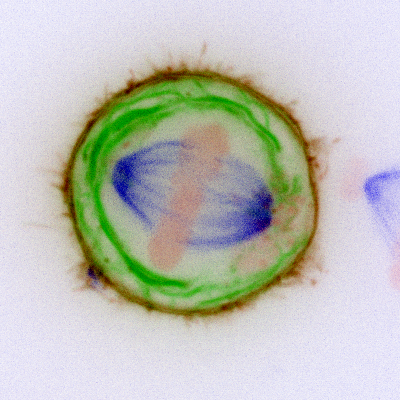The University of Warwick’s research gives fresh information on a major cause of cancer growth during cell division (or mitosis), as well as potential treatments for avoiding it.
 A living cell. Chromosomes (shown in pink) are shared by the spindle (blue). Membranes (green) are a risk factor for correct chromosome sharing. Image Credit: University of Warwick.
A living cell. Chromosomes (shown in pink) are shared by the spindle (blue). Membranes (green) are a risk factor for correct chromosome sharing. Image Credit: University of Warwick.
When a cell divides properly, it duplicates each chromosome and divides the copies evenly between the two new cells. The mitotic spindle is a complicated mechanism in the cell that performs this function.
If something goes wrong at this point, the two new cells will be aneuploid, which means they will not have the right amount of chromosomes and will share genetic information incorrectly.
If cancer cells are aneuploid, it is crucial to understand how and why this arises to figure out where the disease comes from.
This has been discovered by Professor Stephen Royle’s research group at Warwick Medical School.
Researchers discovered that certain chromosomes can become lost and stuck in a tangle of membranes around the cell’s spindle, prohibiting the chromosomes from being properly shared and leading to aberrant cell division, which can lead to cancer.
Researchers discovered it by doing a kind of “surgery” on live cells. The researchers devised a method of removing the tangle of membranes in which chromosomes become trapped, and as a consequence, the spindle retrieved the chromosomes, allowing regular healthy cell division to resume.
For the first time, it was demonstrated that chromosomes stuck in these membranes are a direct risk factor for cancerous cell development. Understanding this risk can help people avoid cancer more effectively.
Many scientists working on cell division focus on the spindle: how it works and why it makes mistakes in cancer. In this paper we shifted the spotlight and looked at membranes inside dividing cells.”
Stephen Royle, Professor, Cell Biology, Warwick Medical School
Dr Nuria Ferrandiz, study lead author of the study stated, “We found that chromosomes can get trapped in membranes and this is a disaster for the dividing cell. It has the potential to change a normal cell into a cancer cell. Preventing this process may be a way to treat disease.”
Source:
Journal reference:
Ferrandiz, N., et al. (2022) Endomembranes promote chromosome missegregation by ensheathing misaligned chromosomes. Journal of Cell Biology. doi.org/10.1083/jcb.202203021.